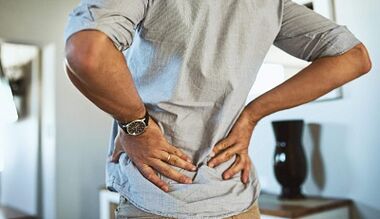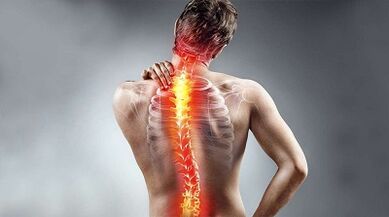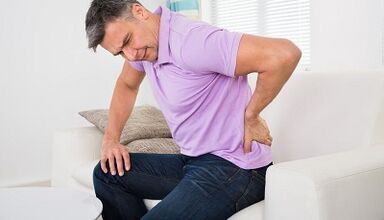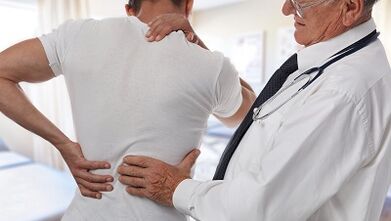
Back pain can occur at all ages, but occurs more often between 35 and 55 years.The pain in the spine is associated with how our bones, muscles, intervertebral disks, ligaments, tendons and nerves work.
The pain in the spine can be caused by problems with the vertebrae, disks between them, ligaments around the spine and disks, spinal cord and nerves, the back muscles, internal organs of the abdominal and pelvic areas.Diseases of the aorta, the tumors of the chest and inflammation of the spine in the upper back can be the cause of the pain in the upper back.
Risk factors
The presence of risk factors increases the likelihood of developing a state.For example, obesity significantly increases the risk of diabetes of the other type.
The following factors are associated with an increase in the risk of back pain.
- office work;
- work associated with constant stress;
- Pregnancy - Pregnant women often suffer from spine pain;
- sedentary lifestyle;
- age;
- depression;
- obesity/excess weight;
- Smoking;
- heavy physical exercises;
- Heavy physical work.
Signs and symptoms of back pain
The symptom is what the patient feels while the doctor may notice the sign.For example, pain is a symptom while a rash is a sign.
The biggest symptom of spine pain is pain in any part of the back.Sometimes the pain extends to the buttocks and legs or to the shoulder and arms.
You should contact your doctor immediately if the pain in the spine accompanies any of the following signs:
- weight loss;
- high temperature (fever);
- Back pain is not eased after rest;
- painful pain;
- Pain that lowers beneath the knee;
- the presence of fresh spinal cord injury;
- Urinary incontinence (even a small part);
- Difficulty with urination - urine is difficult;
- fecal incontinence - loss of control over the defecation process;
- numbness in genitals;
- numbness in the anus;
- Numbness in the buttocks.

Apply for advice from a specialist if you are one of these groups:
- people under 22 years of age or older than 55 years;
- Patients who took steroids for months;
- Patients with cancer;
- Patients who once had cancer;
- Patients with low immunity.
The causes of back pain
The human spine is a complex structure consisting of muscles, ligaments, tendons, disks and bones.Intervertebral discs are placed between each pair of vertebrae and act as shock absorbers of friction.Problems with any of these components can lead to spine pain.In some cases, the causes of pain cannot be established.
Stretch
The most common causes of pain in the spine are:
- stretched muscles;
- stretched ligaments;
- lift a heavy object in the wrong position;
- lifting a too heavy object;
- The result of a sharp and awkward movement;
- Muscle spasm.
Structural problems
The following structural problems can lead to pain in the spine:
- Demonstration of the intervertebral disk.The rupture of the outer sheath of the disk leads to swelling of its inner content outward.This can lead to clamping of the nerve and as a result pain;
- A hernia of the intervertebral disk- Sticking the internal content of the disk in large sizes;
- sciatica- Acute and shooting pain that radiates to the back and back area of the leg caused by projections or hernia on the intervertebral slice and compresses the nerve;
- arthritis- Patients with osteoarthritis usually experience problems with the joints of the thigh, the lumbar spine, the knees and the hands.In some cases, stenosis in the spinal canal may occur as the space around the spinal cord is narrowed;
- Anomal bending of the spine- If the spine bends in an unusual way, the patient is more likely to suffer from pain in the spine.An example of an abnormal bending is scoliosis where the spine bends to the side;
- Osteoporosis- The bones, including the vertebrae, become fragile and porous, leading to an increase in their fragility.

Below are some other causes of pain in the spine:
- Syndrome of the horse's tail- Ponytail is a bunch of nerve roots where the spinal cord is branched.People with a horse syndrome feel dull pain in the lumbar spine and buttocks.There may also be a loss of the sensitivity of the buttocks, the genitals, the thigh.Sometimes people suffer with a horse syndrome of urine and/or faeces;
- spine cancer- The tumor located in the spine can squeeze the nerve, leading to pain;
- Spine infection- If the patient has high body temperature and also has a painful warm area on the back, this may indicate the infection in the spine;
- Other infections- Inflammation of the pelvic organs in women as well as infections of the bladder and kidneys can also cause back pain;
- Sleep disorders- People with sleep disorders more often experience pain in the spine compared to the general population;
- shingles- Infection that can affect the nerves;
- Inappropriate mattress- If the mattress does not support certain parts of the body and do not ensure the back, there is a risk of developing pain in the spine.
The cause of spine pain may also be certain movements or body positions, such as long -term driving, coughing and so on.
What to do when back hurts
If you experience spine pain for several days, the following tips will help you reduce pain and discomfort and speed up improvement:

- Become active as possible;
- If necessary, use painkillers;
- Use hot and cold compressions.A bottle of hot water and a bag of frozen vegetables will be made.
Despite the fact that it is difficult to remain an optimist when you suffer from pain, try not to lose your heart.This will speed up the process of improvement.
With prolonged pain in the spine, which does not go within six weeks, consult a doctor.The doctor will prepare a medical history, conduct an examination and, if necessary, refer it to further examinations.The doctor may prescribe radiography in case of suspected a problem with a bone system or osteoarthritis, CT (computed tomography) or MRI (magnetic resonance tomography) in the event of suspected intervertebral hernia or other problems associated with soft tissue or nerves.In such a situation, MRI is the best choice.The doctor may also advise you to provide some laboratory examinations or measure the electrical activity of the nerves (EMG).
After making a diagnosis, the doctor prescribes treatment.In most cases, there is a sufficient conservative treatment that may include:
- special exercises;
- Reflexology;
- Spinal extension;
- massage.
In severe cases, the question of the operation can be raised.The surgeon helps you choose the appropriate method and also advise on possible complications.Some time after surgery, the bachelor's treatment of the spine is recommended.Remember, the spine is quite dangerous as the operating area is in the immediate vicinity of the nerves.















































